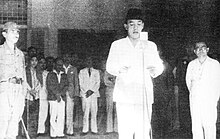Timeline of the Indonesian National Revolution
Appearance
Part of a series on the |
|
|---|---|
| History of Indonesia | |
 | |
| Timeline | |
|
Toba catastrophe | 75,000 BP |
| Buni culture | 400 BCE |
| Larantuka Kingdom | 1515–1904 |
| Kingdom of Bolaang Mongondow | 1670–1950 |
| Dutch East India Company | 1602–1799 |
| British | 1685–1824 |
| French and British interregnum | 1806–1816 |
| Dutch East Indies | 1800–1942 1945–1949 |
| National Awakening | 1908–1942 |
| Japanese occupation | 1942–1945 |
| National Revolution | 1945–1949 |
| United States of Indonesia | 1949–1950 |
| Liberal democracy | 1950–1959 |
| Guided Democracy | 1959–1966 |
| Transition | 1966–1967 |
| New Order | 1967–1998 |
| Reform era | 1998–present |
This is the timeline of Indonesian National Revolution.




This article includes a improve this article by introducing more precise citations. (December 2014) (Learn how and when to remove this message ) |